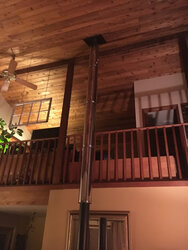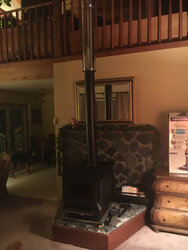I'm a long time lurker and a first time poster... Feel free to comment/bash/flame me all you want, I can take the heat (haha!)
I had my fourth stack fire this morning... I have a new NC-30 (installed this fall). I upgraded from a 1980's model Blaze King Princess for my 1,750-ish sqft. house. We had three stack fires with the BK and I decided that was enough and it was time to change from a 'smoke-dragon' to a 'clean-burning' wood stove.
Hindsight is almost 20/20 and I think the biggest problem with the BK was the bi-metal element on the control damper. I have a two-story open house with about 14' of stack going thru the open living area before it goes thru the ceiling to the outside. We've lived in the house for 16+ years. The original stack was 8" single-wall stack that lasted about 4 years. I would tap it with a stick to knock the creosote off the inside ooccasionally. It held up well till I brushed it and it looked like swiss-cheese. I replaced it and that stack lasted about 3 years, till I cleaned it and it was done. I purchased some higher quality, welded-seam single wall stove pipe from VentingPipe.com (Duravent brand). It was much better initially, but one night we can home and I cracked the door open to get a good draft and build the heat up in the fire. The stack caught fire and the stove pipe opened up along a seam. I closed the wood stove door, but couldn't contain the fire. The local volunteer fire department came and was able to extinguish it without ANY damage to the house. Thank you Jesus!
I replaced that stack and it was a few more years before our next stack fire. Again, we had about 12'-14' of single-wall in the living area and it allowed the smoke to cool down too quickly and create creosote (my assumption). I started a fire using cardboard and it got too hot, too quick. After that incident, I installed several feet of Metalbestos (double-wall) stack from the ceiling to about 4'-5' above the wood stove.
With these two fires, my wife had became leary of our stove and required me to run it very conservatively. One weekend when she was out of town, I opened the damper a little wider than usual and ran it a little hotter. Guess what happened? Another stack fire... After the second stack fire, I installed a garden hose in my mechanical room. I was able to extinguish the stack fire easily by cooling down the double-wall stack and hitting the burning coals with water. The steam caused the hot creosote to expand and fall into the firebox. Problem solved (for the most part). The next day I emptied the 'cool' ashes into a plastic bucket (yes, plastic, bad choice!) and put it in my enclosed entryway. I started a new fire in the stove and kept an eye on it. About a half-hour later, I noticed smoke particulates filling the room. I was investigating the wood stove and had my back to the door going into the entryway. I had a smoldering fire in my entryway. It burned thru the plastic bucket, the plastic container next to it and a stack of newspaper in the plastic container. LESSON LEARNED...
So that takes me to my decision to replace the BK Princess with a new EPA stove. I found the NC-30 at a local hardware store and read reviews of it here on Hearth.com. It seemed like it would do the trick, so I bought it and began the process of removing my 8" stack and replacing it with a 6" one. I completed the install late this summer and fired it for the first time in October. I am fairly pleased with it, but I still can't burn it very hot. My wife is sensitive to the smell of curing paint and how similar it smells to a stack fire. I've been burning the stove at the lower range of 'safe' at about 450f (or less) on the top and 300f (or less) 18" above the stove on the flue pipe. I can get the secondaries to fire when it's heating up, but they don't stay lit very long when I start to cut off the primary air. I'm burning spruce that has been seasoned for at least a year. The front glass is fogging up with creosote, so I know that it's not burning hot enough. I scrape the residue off with a razor blade. A couple weeks ago, I unscrewed the lower two sections of single-wall pipe off and checked them. They had a thin film of glazed creosote on them. This stove might be too much stove for our house. When it get's north of 72f on the thermostat 5' away from the stove, my wife says that its too hot. Understand that 72f downstairs is probably 74f-76f upstairs where she hangs out. I'm sure if I filled the stove and ran it hard, it would be somewhere around 90f, which would be great in my book...
The stack fire we had this morning was very small and occurred in the top 4'-5' of the double-wall stack before it goes thru the ceiling. I'm thinking that's probably the place where the smoke condenses the most and builds up the creosote quickest. I could put my hand on the outside of the pipe and feel it was very hot. We didn't see any flames, but other areas of the pipe were cooler to the touch. I though you couldn't have a stack fire with an EPA stove, because the flame route wouldn't put it in direct contact with the stove pipe. I guess I was wrong...
I'm sure you'll have questions, but here are mine:
Should I get a new smaller, stove?
How often do you clean your stack on your EPA stove?
Do you use any creosote-treatment in your EPA stove? If so, how often?
I had my fourth stack fire this morning... I have a new NC-30 (installed this fall). I upgraded from a 1980's model Blaze King Princess for my 1,750-ish sqft. house. We had three stack fires with the BK and I decided that was enough and it was time to change from a 'smoke-dragon' to a 'clean-burning' wood stove.
Hindsight is almost 20/20 and I think the biggest problem with the BK was the bi-metal element on the control damper. I have a two-story open house with about 14' of stack going thru the open living area before it goes thru the ceiling to the outside. We've lived in the house for 16+ years. The original stack was 8" single-wall stack that lasted about 4 years. I would tap it with a stick to knock the creosote off the inside ooccasionally. It held up well till I brushed it and it looked like swiss-cheese. I replaced it and that stack lasted about 3 years, till I cleaned it and it was done. I purchased some higher quality, welded-seam single wall stove pipe from VentingPipe.com (Duravent brand). It was much better initially, but one night we can home and I cracked the door open to get a good draft and build the heat up in the fire. The stack caught fire and the stove pipe opened up along a seam. I closed the wood stove door, but couldn't contain the fire. The local volunteer fire department came and was able to extinguish it without ANY damage to the house. Thank you Jesus!
I replaced that stack and it was a few more years before our next stack fire. Again, we had about 12'-14' of single-wall in the living area and it allowed the smoke to cool down too quickly and create creosote (my assumption). I started a fire using cardboard and it got too hot, too quick. After that incident, I installed several feet of Metalbestos (double-wall) stack from the ceiling to about 4'-5' above the wood stove.
With these two fires, my wife had became leary of our stove and required me to run it very conservatively. One weekend when she was out of town, I opened the damper a little wider than usual and ran it a little hotter. Guess what happened? Another stack fire... After the second stack fire, I installed a garden hose in my mechanical room. I was able to extinguish the stack fire easily by cooling down the double-wall stack and hitting the burning coals with water. The steam caused the hot creosote to expand and fall into the firebox. Problem solved (for the most part). The next day I emptied the 'cool' ashes into a plastic bucket (yes, plastic, bad choice!) and put it in my enclosed entryway. I started a new fire in the stove and kept an eye on it. About a half-hour later, I noticed smoke particulates filling the room. I was investigating the wood stove and had my back to the door going into the entryway. I had a smoldering fire in my entryway. It burned thru the plastic bucket, the plastic container next to it and a stack of newspaper in the plastic container. LESSON LEARNED...
So that takes me to my decision to replace the BK Princess with a new EPA stove. I found the NC-30 at a local hardware store and read reviews of it here on Hearth.com. It seemed like it would do the trick, so I bought it and began the process of removing my 8" stack and replacing it with a 6" one. I completed the install late this summer and fired it for the first time in October. I am fairly pleased with it, but I still can't burn it very hot. My wife is sensitive to the smell of curing paint and how similar it smells to a stack fire. I've been burning the stove at the lower range of 'safe' at about 450f (or less) on the top and 300f (or less) 18" above the stove on the flue pipe. I can get the secondaries to fire when it's heating up, but they don't stay lit very long when I start to cut off the primary air. I'm burning spruce that has been seasoned for at least a year. The front glass is fogging up with creosote, so I know that it's not burning hot enough. I scrape the residue off with a razor blade. A couple weeks ago, I unscrewed the lower two sections of single-wall pipe off and checked them. They had a thin film of glazed creosote on them. This stove might be too much stove for our house. When it get's north of 72f on the thermostat 5' away from the stove, my wife says that its too hot. Understand that 72f downstairs is probably 74f-76f upstairs where she hangs out. I'm sure if I filled the stove and ran it hard, it would be somewhere around 90f, which would be great in my book...
The stack fire we had this morning was very small and occurred in the top 4'-5' of the double-wall stack before it goes thru the ceiling. I'm thinking that's probably the place where the smoke condenses the most and builds up the creosote quickest. I could put my hand on the outside of the pipe and feel it was very hot. We didn't see any flames, but other areas of the pipe were cooler to the touch. I though you couldn't have a stack fire with an EPA stove, because the flame route wouldn't put it in direct contact with the stove pipe. I guess I was wrong...
I'm sure you'll have questions, but here are mine:
Should I get a new smaller, stove?
How often do you clean your stack on your EPA stove?
Do you use any creosote-treatment in your EPA stove? If so, how often?




